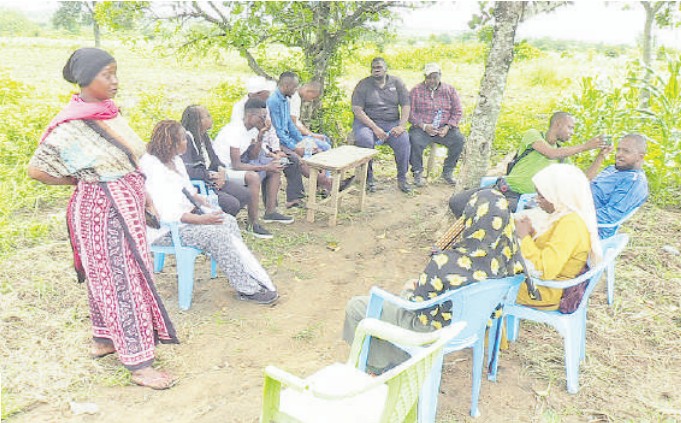

In the lush but once-battered village of Patanani in Kwale county’s Lunga Lunga subcounty, a quiet transformation is taking place.
Amid the gentle thrum of falling rain, farmers are busy tilling land and rebuilding the ecosystem.
For decades, unchecked logging and charcoal burning stripped this part of the coast of its forest cover, leaving behind cracked soil and desolate tree stumps.
However, today the same farmers are nurturing the land back to life — one tree at a time, thanks to the Restore Africa initiative.
The initiative, supported by World Vision Kenya and the Kwale government, is mobilising farmers to plant trees and tap into the global carbon credit market.
Already, more than 250,000 seedlings have been planted across Kinango, Lunga Lunga and Shimba Hills subcounties.
The goal is to reach 70,000 acres and 50,000 farming families within five years.
Saidi Ndaro, 70, has seen the worst. Standing beside his wife, Fatuma Ndaro, he recounts when the land was green and generous, fed by predictable rains and shielded by thick forest canopies.
“When I was a child, this area was fertile and full of life. But the trees disappeared. We used to think they would grow back on their own. They didn’t,” Ndaro recalls.
His wife, Fatuma, was the first to sign up for the restoration programme.
Sceptical at first, Ndaro only joined after watching the barren stumps on their five-acre farm sprout fresh leaves under his wife’s care.
“We were taught about ‘visiki hai’, the live stumps that you don't uproor — you prune, protect and water. Slowly, they will come back to life,” Fatuma said.
Her work has revived more than 100 indigenous tree stumps, including Mikone, Mipalanda and Mwarobaini, all of which are key to absorbing carbon dioxide from the atmosphere.
She has also planted fruit trees like mango and cyprus, blending conservation with productivity.
“At first, I thought these stumps were dead waste. Now, they are my most valuable assets,” Fatuma said.
She and her neighbours are using a method known as Farmer-Managed Natural Regeneration (FMNR) — a low-cost, sustainable land restoration approach that leverages natural tree root systems.
It is a practice that is drawing new hope in a region battered by climate change.
For Fatuma, every seedling is more than just a tree — it’s a memory, a lesson and an investment in her grandchildren’s future.
“The trees brought the rain back and with the rain, hope returned too,” she said, looking at the green canopy that has reclaimed the hillsides
Maurice Bati, a neighbour to the Ndaros, echoes the optimism.
“We’re expecting to start earning from carbon credits by 2029. Everyone is doing their part, because now we see the benefits clearly,” he said.
Carbon credits are a form of tradeable certificates that represent the removal of a specific amount of carbon dioxide from the atmosphere. They are a potentially game-changing incentive for these farmers.
Under the Restore Africa model, developers will assess the carbon stored every five years and communities will earn from it for up to 30 years.
Dismus Nyaga, Restore Africa’s county manager in Kwale, said the programme was designed with the farmer in mind.
“It doesn’t disrupt their normal farming activities. They can grow crops between trees. The more they plant and preserve, the more they stand to gain,” he said.
Vivian Kiprotich, technical specialist for natural resource management with Restore Africa, said restoring tree cover is one of the most effective ways to reclaim degraded lands.
“We are not just planting trees. We are planting futures. Every tree improves soil quality, retains moisture and stabilises the local climate. And when these trees grow, they help pull carbon from the air,” she said.
The initiative is part of a larger movement led by the Global EverGreening Alliance, operating in Kenya, Uganda and Malawi.
In Kenya, World Vision leads a coalition of partners, including JUSTDIGGIT, Self Help Africa, Green Belt Movement, Icraf and Africa Harvest. They work across five counties of Kwale, Kilifi, Narok, Migori and Elgeyo Marakwet.
In Kwale, the final phase of the tree planting will take place during the long rains of 2026, marking a vital milestone in the region’s fight against climate change and poverty.
Instant analysis
Kwale farmers are right to embrace forest restoration through the Restore Africa initiative. With erratic rainfall, depleted soil, and vanishing biodiversity, their shift to agroforestry and Farmer-Managed Natural Regeneration (FMNR) not only revives the land but aligns with the global push for climate resilience. The promise of carbon credit earnings adds economic incentive, turning conservation into livelihood. By blending indigenous knowledge with modern training, these farmers are restoring ecosystems while preparing to tap into the billion-dollar carbon market.











![[PHOTOS] Elgeyo Marakwet landslide victims arrive in Eldoret for care](/_next/image?url=https%3A%2F%2Fcdn.radioafrica.digital%2Fimage%2F2025%2F11%2F425460d9-7ff1-4975-8a1f-cd0aaefb7812.jpg&w=3840&q=100)

